Household Wealth
This quarterly report on the wealth of Irish households complements the statistical releases for Irish Quarterly Financial Accounts with more detail on households' assets and liabilities and a breakdown by wealth distribution.
Key Points – Q2 2025
Publication date: 27 November 2025
- The net wealth of Irish households reached €1,288.1bn at the end of Q2 2025, increasing by €39.5bn since the previous quarter.
- Total household investment of €12.3bn was mainly driven by investment in currency and deposits and new housing assets.
- The total value of housing assets owned by Irish households increased by €19.0bn since the previous quarter, largely due to positive revaluations.
- As of Q2 2025, the wealthiest 10 per cent of households held 49.3 per cent of total net wealth in the country.
In addition to the latest Q2 2025 data, this release incorporates revisions for reference periods Q1 2013 to Q1 2025 that took place as part of the regular annual revisions of Irish macroeconomic statistics.
Chart 1 – Total net wealth of Irish households
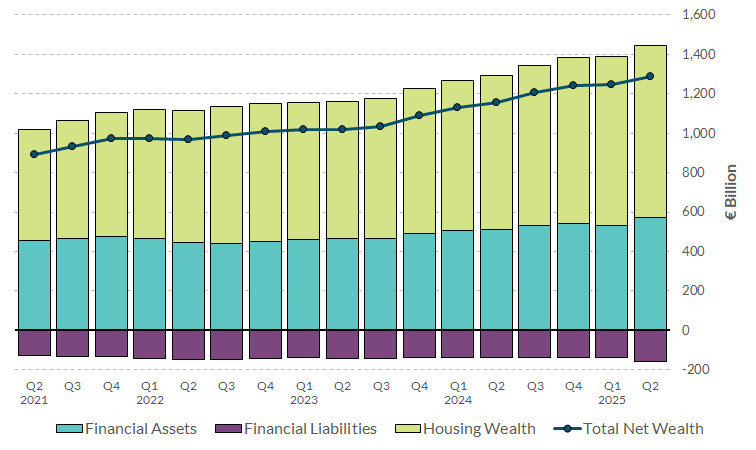
View data for chart 1 (XLSX 20.91KB)
Total net wealth of Irish households rose by €39.5bn to stand at €1,288.1bn in Q2 2025. This represents a new series high, continuing the pattern of growth seen in recent years.
The overall increase in net wealth was driven by a rise in financial assets, which increased by €37.6bn.
Households’ financial assets stood at €570.3bn at the end of Q2 2025 and were mainly composed of currency and deposits (€215.7bn) and insurance and pension entitlements (€260.3bn).
Housing wealth increased by €19.0bn to reach €873.9bn. This accounts for 67.8 per cent of total net wealth and 60.5 per cent of the total assets of Irish households.
Total liabilities, mainly consisting of long-term loans, totalled €156.1bn. This amount increased by €17.1bn from the end of the previous quarter.
Chart 2 – Quarterly investment of Irish households, by instrument
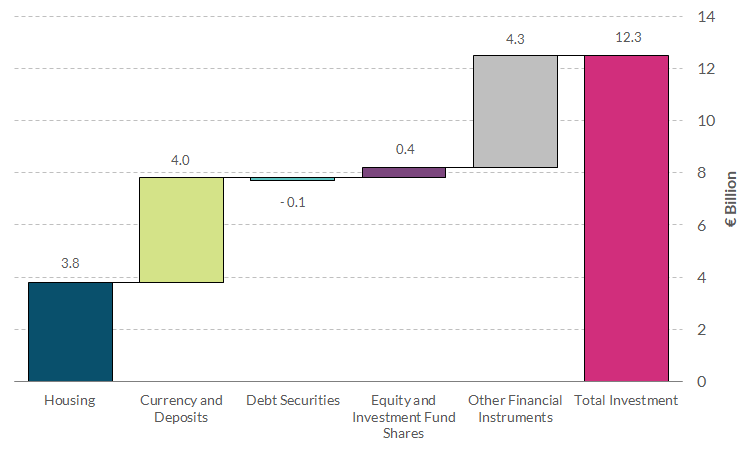
View data for chart 2 (XLSX 14.78KB)
Households’ total investment in new housing and financial assets totalled €12.3bn in Q2 2025. Of this, investment in new housing equalled €3.8bn, which is €1.5bn higher than in the previous quarter. Financial investments were primarily in currency and deposits (€4.0bn), and in other financial instruments (€4.3bn). The latter include investment in pension entitlements of €2.8bn.
In recent years, Irish households have generally displayed positive quarterly investment in housing and financial instruments, with the only significant exceptions being some divestments in insurance and pension entitlements in some quarters.
Chart 3 – Household leverage indicators
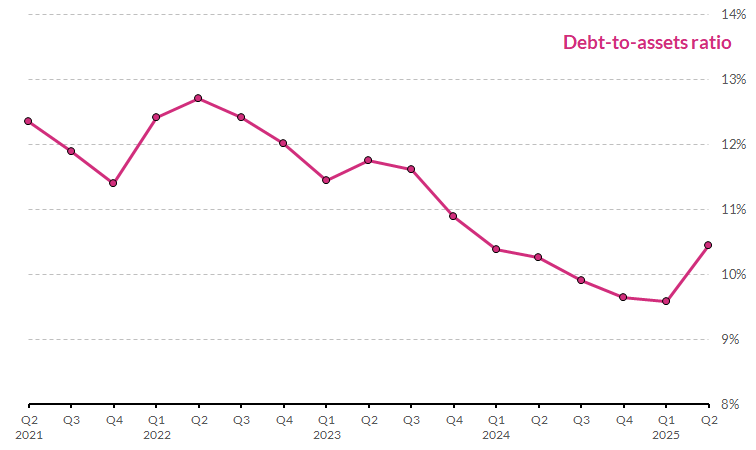
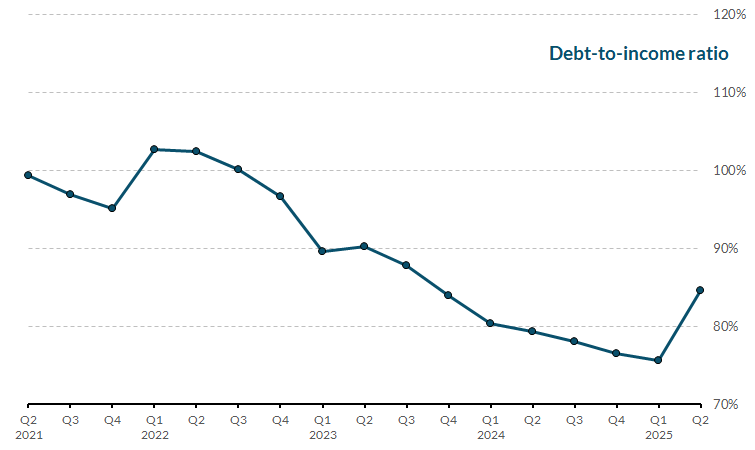
View data for chart 3 (XLSX 21.84KB)
As of Q2 2025, total household assets increased by €56.6bn. However, given the increase in household loans, which grew by €17.9bn to reach €151.0bn, this led to an increase in the debt-to-assets ratio of Irish households, to 10.5 per cent.
The debt-to-income ratio of Irish households also increased to reach 84.7 per cent at the end of the quarter. Data from the Central Statistics Office (CSO) shows that household gross disposable income (on an annualised basis) equalled €178.3bn as of Q2 2025.
Chart 4 – Total net wealth of Irish households, by wealth decile
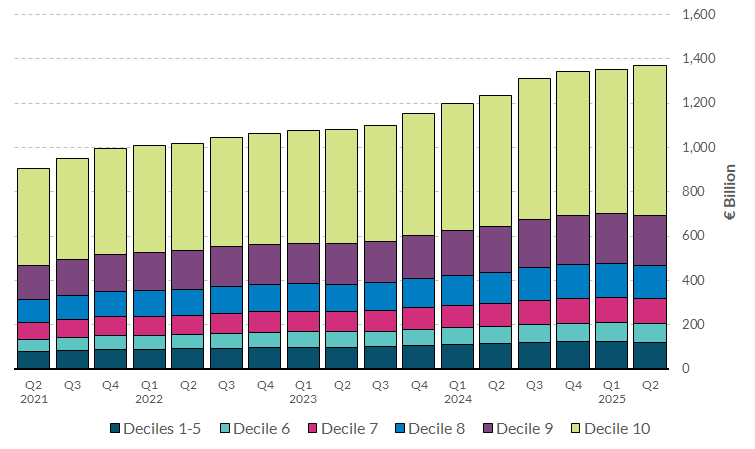
View data for Chart 4 (XLSX 31.99KB)
Distributional Wealth Accounts (DWA) data provide insights on the distribution of wealth across Irish households.
As of Q2 2025, the wealthiest 10 per cent of Irish households owned €674.9bn, or 49.3 per cent of total household net wealth in the country.
The total net wealth of households in the poorest half of the distribution fell by €4.2bn (3.3 per cent) to stand at €120.7bn, or 8.8 per cent of the national total. This was mainly due to increased loan undertaking in the period.
As of Q2 2025, the richest 10 per cent of Irish households held more than five times the amount held by households in the bottom half of the net wealth distribution altogether.
Households in the “middle” part of the distribution (i.e., those in deciles 6 to 9) owned €572.7bn overall, or 41.9 per cent of total net wealth in the country at quarter-end.
Chart 5 – Balance sheet composition of Irish households, by wealth decile
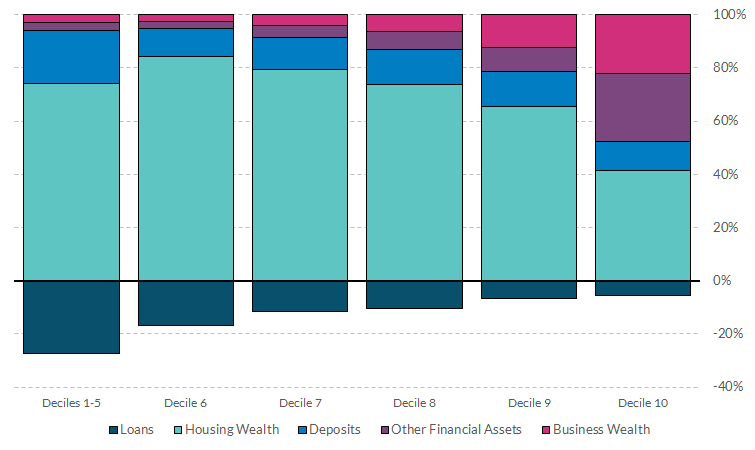
View data for chart 5 (XLSX 25.73KB)
The balance sheet composition of Irish households differs significantly between the wealthier and poorer.
Overall, as of Q2 2025, households in the top net wealth decile displayed a more diversified portfolio composition. In particular, other financial assets (i.e., debt securities, listed shares, investment fund shares, and life insurance and annuity entitlements) featured prominently, accounting for 25.5 per cent of total assets. Wealthier households also displayed lower leverage (5.4 per cent), when compared to households in the bottom half of the wealth distribution.
Conversely, poorer households held the largest part of their financial wealth in deposits (19.6 per cent of their total assets) and were significantly more leveraged (27.5 per cent).
For all household groups, housing assets represent the main component of their wealth.
The balance sheet composition of households in each wealth decile remained almost unchanged from the previous quarter. Since the beginning of the series, these proportions have been generally stable over time.
Chart 6 – Gini coefficient of wealth inequality

View data for chart 6 (XLSX 19.79KB)
As of Q2 2025, the Irish Gini coefficient (a widely used measurement of wealth inequality) was 64.9.
This remained well below the value of the same index for the euro area as a whole (72.3) and of most other European countries, as it has been for the past years. Moreover, since the beginning of the series, the Gini coefficient for Ireland decreased significantly (-11.6 points), indicating a notable reduction in the level of wealth inequality in the country.
The sustained de-leveraging process of poorer households and the rise in value of housing assets over the years – which mainly benefited households for whom this asset represents a larger component of their total wealth (i.e., mid-lower deciles) – drove the increase in the share of total net wealth held by the poorest half of households. As a result, net wealth inequality in Ireland significantly decreased since the beginning of the series.
Documents
Household Wealth Report - 2025 Q2 | pdf 465 KB
Household Wealth Report - Glossary | pdf 424 KB
Household Wealth Report - Publication Notes | pdf 246 KB